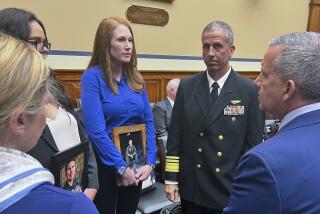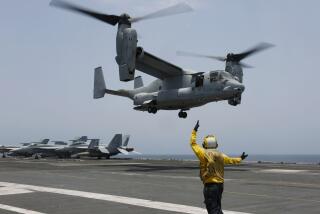Marines’ Faith, Fates Rest With Helicopter
EL TORO — Its sides are covered with metal patches from Vietnam-era bullet holes, its parts replaced countless times. A quarter of a century old, it has little of the high-technology equipment of today’s war-making machines.
But when Sgt. Jeff Furmanek hears political types in Washington attack the spotty record of his CH-46 Sea Knight helicopter, it’s personal.
“They’re attacking your plane,” said the blond, 25-year-old Marine from Garden Grove. “Your name’s on the side. It’s like someone’s cutting down your mother.”
Sometime within the next few weeks, a Sea Knight with Furmanek’s name on the side and a dozen others like it will leave El Toro Marine Corps Air Station for North Carolina and then--in all likelihood--for the Persian Gulf. There, the choppers will wait on land or boat for possible use in shuttling troops and supplies to the front lines of an armed conflict with Iraq.
As they hurried Thursday to ready the Sea Knights for war, some of the 200 Orange County men from the 764th Medium Marine Helicopter Squadron who will fly and run the choppers grimly acknowledged that their lives are at stake in the mission. But in a very real sense, they said, the deployment also offers one final chance to prove the critics wrong about their aircraft.
The Sea Knight has had a rough ride in recent years. There have been at least 14 fatal crashes of the model in the last decade, killing several dozen servicemen. Critics of the helicopter have pointed to such tragedies to try to speed up the model’s planned retirement and replace it with the V-22 tilt-rotor aircraft.
And following a May crash at Twentynine Palms that injured 17 Marines, the Pentagon grounded the entire fleet of 342 Sea Knights to explore reports of systemic mechanical problems. It was the craft’s second grounding in the span of just a few weeks.
The groundings and subsequent dismantling of the choppers for review left members of the 764th at El Toro with extra time on their hands earlier this year. “You’re sitting around with no parts to work with, and it’s dull,” said Sgt. Chase Hawkins, a 26-year-old Kentucky native who works on a maintenance and inspection crew for the CH-46.
But now that the CH-46 Sea Knight has been deemed fit for action and the 764th has been given its orders, extra time hasn’t been a worry.
“We’re humping,” said Hawkins, who was on his last leg of deactivation for military retirement when he got the call two weeks ago to ship out with the 764th to points unknown. “Everybody’s pretty stressed out. Twelve (hours) on, 12 off--you get that way.”
The new assignment for the 764th has meant the biggest deployment of Orange County reservists so far in the Gulf crisis--about 100 men in all. Once the reservists had finished certifying their next of kin and filling out the paperwork earlier this week, they joined about 100 active soldiers from the squadron to ready their 13 Sea Knights in time to get to Cherry Point, N.C., by Dec. 5 as ordered.
The work went in spurts Thursday afternoon, broken up by interviews with a reporter and a review by a visiting general. In between, there were head rotors and transmissions to be reinstalled. There were extra inspections to be made, a result of the recent crashes. And there were launch tests to be monitored, all on a tight timetable.
But the men--the squadron’s two women are banned from the combat mission under military policy--were fervent in their belief that the Sea Knight’s problems have been overblown.
Capt. Jerry Toth said he never would have signed up with the Marine reserves earlier this month if he did not believe so.
Having just ended eight years of active military service, the 30-year-old pilot is in the unusual position of having signed up for reserve duty after the hostilities in the Persian Gulf broke out. His squadron--the 764th--was called to active duty before he had even gotten a chance to drill with it during the regular weekend regimen.
“It was a job that needed to be done,” he explained. As he prepared to leave behind a new job in aviation sales and a wife and a 14-month-old son in Tustin, Toth said he knows what the Sea Knight can do and has confidence in it.
“No one’s putting a gun to my head and making me fly that machine,” he said.
Said Cpl. Robert Scott, who heads a helicopter crew: “I’ve got 1,500 hours (in the air), and I’ve yet to crash one. . . . I’m very comfortable with that aircraft. No hesitation.”
So how does one explain the Sea Knight’s recurring problems and the attention it has drawn in Washington?
“Politics,” one sergeant barked. “They’re just exploiting the crashes,” added another.
Sgt. Furmanek, a husband and the father of an infant in Irvine, explained it this way as he pondered the next few months in the Persian Gulf and gently patted the fatigue-colored shell of Sea Knight No. 425, the one that bears his name in large block letters on its head:
“This is something that’s going to bring me home safe. It’s got a lot of bullet holes. It made it once--in Vietnam--and it’s gonna make it again.”
More to Read
Sign up for Essential California
The most important California stories and recommendations in your inbox every morning.
You may occasionally receive promotional content from the Los Angeles Times.










